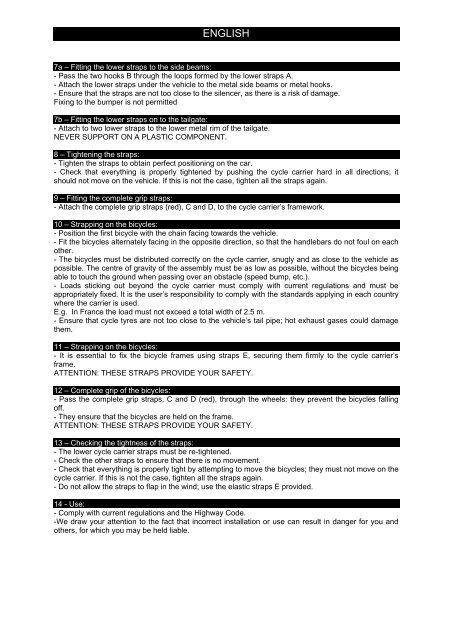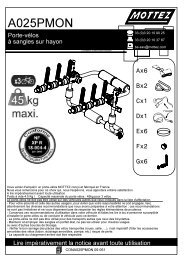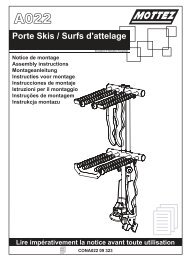L:\1 AUTOMOBILE\A014PFV\Notice\Page 1 A014.CATDrawing
L:\1 AUTOMOBILE\A014PFV\Notice\Page 1 A014.CATDrawing
L:\1 AUTOMOBILE\A014PFV\Notice\Page 1 A014.CATDrawing
You also want an ePaper? Increase the reach of your titles
YUMPU automatically turns print PDFs into web optimized ePapers that Google loves.
ENGLISH<br />
7a – Fitting the lower straps to the side beams:<br />
- Pass the two hooks B through the loops formed by the lower straps A.<br />
- Attach the lower straps under the vehicle to the metal side beams or metal hooks.<br />
- Ensure that the straps are not too close to the silencer, as there is a risk of damage.<br />
Fixing to the bumper is not permitted<br />
7b – Fitting the lower straps on to the tailgate:<br />
- Attach to two lower straps to the lower metal rim of the tailgate.<br />
NEVER SUPPORT ON A PLASTIC COMPONENT.<br />
8 – Tightening the straps:<br />
- Tighten the straps to obtain perfect positioning on the car.<br />
- Check that everything is properly tightened by pushing the cycle carrier hard in all directions; it<br />
should not move on the vehicle. If this is not the case, tighten all the straps again.<br />
9 – Fitting the complete grip straps:<br />
- Attach the complete grip straps (red), C and D, to the cycle carrier’s framework.<br />
10 – Strapping on the bicycles:<br />
- Position the first bicycle with the chain facing towards the vehicle.<br />
- Fit the bicycles alternately facing in the opposite direction, so that the handlebars do not foul on each<br />
other.<br />
- The bicycles must be distributed correctly on the cycle carrier, snugly and as close to the vehicle as<br />
possible. The centre of gravity of the assembly must be as low as possible, without the bicycles being<br />
able to touch the ground when passing over an obstacle (speed bump, etc.).<br />
- Loads sticking out beyond the cycle carrier must comply with current regulations and must be<br />
appropriately fixed. It is the user’s responsibility to comply with the standards applying in each country<br />
where the carrier is used.<br />
E.g. In France the load must not exceed a total width of 2.5 m.<br />
- Ensure that cycle tyres are not too close to the vehicle’s tail pipe; hot exhaust gases could damage<br />
them.<br />
11 – Strapping on the bicycles:<br />
- It is essential to fix the bicycle frames using straps E, securing them firmly to the cycle carrier’s<br />
frame.<br />
ATTENTION: THESE STRAPS PROVIDE YOUR SAFETY.<br />
12 – Complete grip of the bicycles:<br />
- Pass the complete grip straps, C and D (red), through the wheels: they prevent the bicycles falling<br />
off.<br />
- They ensure that the bicycles are held on the frame.<br />
ATTENTION: THESE STRAPS PROVIDE YOUR SAFETY.<br />
13 – Checking the tightness of the straps:<br />
- The lower cycle carrier straps must be re-tightened.<br />
- Check the other straps to ensure that there is no movement.<br />
- Check that everything is properly tight by attempting to move the bicycles; they must not move on the<br />
cycle carrier. If this is not the case, tighten all the straps again.<br />
- Do not allow the straps to flap in the wind; use the elastic straps E provided.<br />
14 - Use:<br />
- Comply with current regulations and the Highway Code.<br />
-We draw your attention to the fact that incorrect installation or use can result in danger for you and<br />
others, for which you may be held liable.





